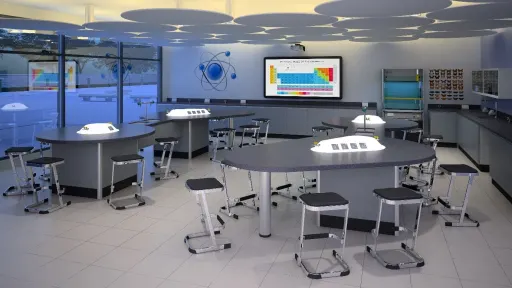ICT in Education: Limitless Benefits for Modern Classroom
Revolutionizing Education: The Limitless Benefits of ICT in the Modern Classroom
The Importance of Integrating Technology into Modern Education
Technology is everywhere, and it has become an integral part of our daily lives. It has transformed the way we learn, work, and communicate.
In recent years, technology has made a significant impact on the education sector. ICT or Information and Communication Technology in education refers to the use of digital technology to enhance teaching and learning processes.
An Overview of ICT in Education
ICT in education encompasses a wide range of technologies, including computers, tablets, smartphones, interactive whiteboards, virtual learning environments (VLEs), e-learning platforms, educational software applications and online resources such as blogs or podcasts. The use of ICT in education is not new.
Teachers have been incorporating technology into their lessons for decades: from using overhead projectors to show slides to using presentation software such as PowerPoint to create visual aids for lectures. However, with the advancement of technology over the years, the potential for its use in enhancing teaching and learning has increased dramatically.
The Importance of Technology in Modern Education
In today’s digital age where information is easily accessible with just a few clicks or taps on our gadgets, students need a different set of skills than they did before – skills that enable them to navigate and utilize digital tools effectively. Incorporating technology into modern education helps prepare students for this reality by providing them access to information beyond traditional textbooks while facilitating engagement with lessons through interactive multimedia tools such as videos and virtual simulations.
Moreover, students who are accustomed to using technology in their day-to-day activities find it easier to transition into virtual learning environments when circumstances require remote instruction. These are just a few examples highlighting how integrating ICT into modern education systems provides countless opportunities for both educators and learners alike.
Access to Information
The Internet: A Gateway to Unlimited Knowledge
The internet has revolutionized the way we access information. Gone are the days when students had to rely solely on textbooks for research.
With ICT, students can now access unlimited knowledge from around the world, all at their fingertips. Online research provides students with vast amounts of relevant information that they can use for their assignments, projects, and presentations.
Digital Libraries: A Treasure Trove of Information
Digital libraries have become a crucial resource for students and researchers alike. They provide access to journals, articles, books, and other academic resources that might not be available in traditional libraries. Moreover, digital libraries can be accessed from anywhere in the world as long as you have an internet connection.
How ICT Helps Students Access Information Beyond Textbooks
ICT has made it possible for students to access information beyond textbooks through various online platforms and apps. For instance, Google Scholar is a search engine specifically designed for academic research that helps students find scholarly articles and papers on any topic of interest. Additionally, online encyclopedias like Wikipedia are constantly updated with the latest information on various topics.
ICT has made it easier than ever for students to access information beyond textbooks through online research and digital libraries. This ease of access enables them to broaden their knowledge base while also bettering their skills in critical thinking and analysis by having more resources at hand to analyze and compare data from different sources.
Interactive Learning
Multimedia Tools Take Learning to the Next Level
Gone are the days when a teacher had to rely solely on outdated textbooks and chalkboards as teaching aids. Nowadays, with ICT in education, multimedia tools play a significant role in making learning interactive and engaging.
Multimedia tools include videos, images, animations, and audio recordings that help students understand complex concepts easily. Teachers can use multimedia tools to create visually appealing presentations that capture students’ attention and reinforce their understanding of key topics.
Virtual Simulations and Educational Games Make Learning Fun
Who says learning has to be boring? With virtual simulations and educational games, learning becomes fun!
Virtual simulations provide a safe environment for students to experiment with real-world scenarios without any risks. For instance, science students can use virtual simulations to perform experiments that are not possible in their classrooms or homes.
On the other hand, educational games turn learning into an enjoyable experience by gamifying lessons. Students can learn about history by going on a virtual adventure or practice math skills by playing math games.
Multimedia tools expand the scope of traditional teaching methods while virtual simulations and educational games make learning exciting for students while providing opportunities for experimentation with real-life situations without any risks involved. The integration of these interactive methods into modern education systems not only improves student engagement but also helps them retain information better than ever before!
Personalized Learning
How ICT Enables Personalized Learning Experiences
In recent years, there has been a shift towards personalized learning experiences that cater to students’ individual needs and learning styles. This is where ICT comes in. Through the use of ICT tools such as e-learning platforms, educational software, and online assessment tools, educators can create customized learning paths for each student based on their strengths and weaknesses.
Customized Learning Paths Based on Individual Needs
One advantage of personalized learning is that it allows each student to progress at their own pace. With ICT tools such as adaptive learning software, students can receive instant feedback and adjust their learning path accordingly. For example, if a student struggles with a particular topic, the software will provide additional resources to help them understand the concept before moving on.
Another benefit of personalized learning is that it allows students to take ownership of their education. By providing them with choices in terms of what they learn and how they learn it, students are more likely to be engaged and motivated throughout the learning process.
ICT enables educators to create personalized learning experiences that cater to each student’s individual needs and preferences. This not only helps students achieve academic success but also fosters a love for lifelong learning.
Collaboration and Communication
As technology continues to evolve, it is becoming increasingly evident that ICT provides many benefits to students and educators alike. One of the most significant advantages of using technology in education is its ability to facilitate collaboration between students and teachers. With ICT, learners can interact with their peers in ways that were once impossible, leading to a more engaging and interactive learning experience.
How ICT promotes collaboration among students and teachers
In today’s digital age, online discussion forums have become a popular way for learners to collaborate on different projects. These forums allow learners to exchange ideas and share knowledge with each other even when they are not physically present in the same location.
In addition, group projects can be easily coordinated through email or file-sharing tools such as Google Drive or Dropbox. This way, students can work together regardless of their location.
Benefits of online discussion forums, group projects, and video conferencing
The benefits of online discussion forums are numerous. For one thing, they provide a platform for students who may feel uncomfortable speaking up in class to contribute meaningfully to discussions. Additionally, online forums enable learners from diverse backgrounds to share their perspectives on various topics without fear of judgment or ridicule.
Group projects also offer several benefits for both learners and educators. By working collaboratively on a project, students learn valuable teamwork skills that will serve them well throughout their lives.
Teachers can also monitor these groups closely using digital tools such as classroom management software or learning management systems (LMS). Last but not least are video conferencing tools such as Skype or Zoom that provide an excellent way for educators to interact with remote students face-to-face virtually.
This technology helps remove geographical barriers by making it possible for learners from different countries or regions of the world to engage with each other in real-time. ICT is an essential tool for modern education.
The benefits of using technology in the classroom are numerous, with collaboration and communication being among the most significant. Through online discussion forums, group projects, and video conferencing, learners can work together more effectively and interact with their teachers in new and innovative ways.
Assessment and Feedback: The Benefits of Online Tools
One of the most challenging aspects of teaching is grading student assignments. Traditional assessments such as paper-based tests, essays, and projects are time-consuming to grade and provide limited opportunities for feedback. However, with the use of online assessment tools, grading can become more efficient while still providing valuable feedback to help improve student performance.
Efficient Grading
Online assessment tools allow teachers to create and grade assignments digitally. This means that teachers no longer need to spend hours sifting through piles of papers or carrying around stacks of exams.
Instead, they can easily grade assignments from their computer or mobile device. These tools also have features like automatic grading which help reduce the time it takes for teachers to grade assignments.
Immediate Feedback
In addition to being more efficient, online assessment tools also provide immediate feedback for students. With traditional assessments, students may not receive feedback for days or even weeks after completing an assignment.
This delay can make it difficult for students to know what they did wrong and how they can improve in the future. Online assessment tools, on the other hand, provide instant feedback that is specific and actionable.
For example, a student may receive a message indicating that they need more detail in their answer or reminding them about a concept they might have forgotten. This kind of immediate feedback helps students identify their strengths and weaknesses so they can focus on improving areas where they may be struggling.
Online assessment tools are a valuable resource for both teachers and students alike. By using these digital tools instead of traditional paper-based assessments, educators can save time while still providing meaningful feedback to help improve student performance.
Flexibility and Convenience
Virtual Learning for a Busy Schedule
One of the greatest advantages of integrating ICT into the education system is the ability to offer remote learning opportunities. This means that students can access their coursework from anywhere, at any time.
This is especially useful for students who have busy schedules, work commitments, or live in remote locations. E-learning platforms have become more sophisticated in recent years, allowing teachers to provide course materials such as videos, audio recordings, interactive quizzes and digital textbooks.
Scheduling Classes Around Life
E-learning also provides flexibility when it comes to scheduling classes. Traditional classroom settings often require students to attend classes at set times each week.
With e-learning, students can often choose when they want to engage with course materials and complete assignments according to their own schedules. This allows students to work around other commitments such as part-time jobs or family responsibilities.
The Rise of Digital Course Materials
With traditional classrooms comes a reliance on physical textbooks and printed handouts which can be expensive and create waste over time. E-learning platforms offer a more sustainable alternative by providing digital course materials that are accessible 24/7 on any device with internet access. Digital textbooks are often cheaper than printed ones too.
Overall, e-learning provides a level of flexibility and convenience that traditional classroom settings cannot match. As technology continues to evolve, we’re likely to see more schools shift towards incorporating ICT into their curriculum in order to accommodate the needs of all learners – no matter where they are in the world!
Cost-Effectiveness
Another significant benefit of incorporating ICT in education is the cost-effectiveness it offers. Traditional classroom materials such as textbooks, paper, and other stationery come with substantial costs that can be avoided by implementing digital solutions.
E-learning platforms provide an opportunity for students to access course materials that are not only affordable but up-to-date as well. With the use of e-books, online articles, and other learning materials available on the internet, students can save money while still maintaining high-quality education standards.
The Cost of Paper
It’s no secret that schoolwork often involves a lot of paperwork – from handouts and worksheets to essays and research papers. The cost of paper alone can add up quickly over time.
Printing costs also add up for both schools and individual families. By reducing or eliminating these expenses with ICT solutions like digital submissions or online assignments, schools can significantly reduce their overall expenses.
The Travel Factor
With e-learning platforms being readily available today, students no longer need to travel long distances to attend classes physically. This saves them transportation costs as well as time spent traveling back and forth from home to school every day.
Teachers also benefit from reduced travel expenses since they no longer have to commute daily from one location to another. Technology has revolutionized the way we approach education today by providing efficient ways for learning that are both cost-effective and convenient for everyone involved.
Conclusion
Bringing Education into the Future with ICT
There are numerous benefits to integrating ICT into modern education systems. The information age has brought a plethora of technological advancements that have revolutionized the way we live and work, and it is only reasonable that education also adopts these advancements. By doing so, students are exposed to an array of resources that facilitate independent learning through interactive multimedia tools, virtual simulations, and educational games.
Promoting Collaboration and Communication
Moreover, the use of online discussion forums, group projects, and video conferencing have created an environment where students can interact with their peers as well as their instructors. This interaction has led to increased participation in classroom discussions, breaking down geographic barriers in collaboration projects and improving the overall learning experience.
The Future is Personalized Learning
ICT has also facilitated personalized learning experiences by customizing learning paths based on individual needs. Through e-learning platforms, students can access course materials at their own pace allowing for flexible schedules while reducing travel expenses for both teachers and students.
Cost-effective Learning: Saving Money While Providing Quality Education
The cost-effectiveness of eLearning platforms has significantly reduced costs associated with traditional classroom materials such as textbooks or paper- this benefits not just students but educators too. Teachers can now grade more efficiently using online assessment tools which provide instant feedback enabling them to improve student performance.
Moving Forward- Embracing Change for a Better Tomorrow
It’s crucial now more than ever before that education technology is incorporated within our schools’ curriculums- preparing future generations for success in a technologically advanced world likely to continue developing at breakneck speeds. As educators continue exploring new ways of integrating technology into classrooms worldwide—ICT will soon become an indispensable tool they cannot do without.




Good Work